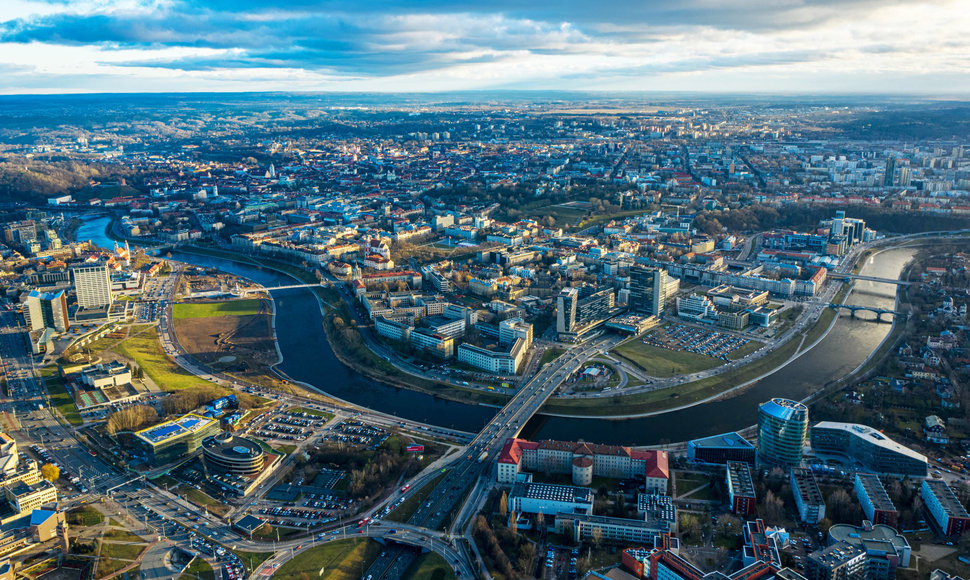The results were revealed by a public opinion and market research company Spinter Tyrimai survey commissioned by the Darnaus Miesto Laboratorija [Harmonious City Lab], which was founded by Darnu Group to assemble harmonious environment creation competences. The survey sought to find out the opinions of Vilnius city residents on satisfaction with the districts they live in and the perceived best home district in Vilnius, asking respondents to answer questions detailing pros and cons.
Senamiestis stands out
During the study, it was found that the average satisfaction of Senamiestis residents in regard to their living environment averaged 9.19 points of the 10 possible during the survey, exceeding the city-wide average by 1.2 points. Second place went to Žirmūnai district with 8.51 points, while Naujamiestis was third with 8.47 points.
The survey shows that overall, Vilnius residents are rather happy with their living environment – the average contentment with one’s living district is 7.96 out of 10. Even the residents least happy with their districts gave their districts’ traits ratings ranging between 7.38 to 7.52 points.
“We can celebrate that Vilnius residents are happy to live in their beloved city and they enjoy and value its advantages. However, looking in more depth, the survey’s figures, which reveal each district’s pains and flaws, are also very noticeable,” one of the country’s largest living, business and leisure spaces company Darnu Group, which founded Darnaus Miesto Laboratorija, CEO Sigita Survilaitė-Mekionienė commented on the study.
According to her, the survey results show that all Vilnius residents find there to be a lack of parking spaces. However, the residents of most districts in the city are positive about the development of their living environment’s infrastructure, transport links to other parts of the city and the offering of services.
“According to the survey, the factors most influencing contentment or discontentment with one’s district are the development of living spaces and infrastructure in it, the quality of transportation to the city centre and other districts, also traffic jams or their non-presence, as well as car parking questions. Vilnius residents also named security and the neatness of surroundings as traits of a quality residential area,” S. Survilaitė-Mekionienė said.
Objective data for the search of the best solutions
This is the second Darnaus Miesto Laboratorija project, which studies urban problems and gathers specialists from various domains for discussions, proposing and implementing specific solutions for particular problems.
According to S. Survilaitė-Mekionienė, currently the social initiative’s aim is to raise questions as to what Vilnius’ city planning, architecture, infrastructure and solutions, which contribute to a more positive resident and city guest experience and living, should be like, without limiting ourselves to current capabilities.
“By performing a study of Vilnius residents’ satisfaction with their districts, we sought to find the locations in the capital, where there is an objective lack of urban solutions or particular attention to the local communities’ concerns. At the same time, we sought to grasp in sufficient detail the problems that residents care about most and identify the specific traits of the district, which make residents the happiest,” S. Survilaitė-Mekionienė notes.
According to her, Vilnius is the most rapidly growing capital in the region, which has a vast potential for continued improvement and progress. However, the energy of this growth should be channelled with forethought, making decisions, which would create a quality environment for living, working and resting across the city, prioritising sustainable and long term solutions.
For example, the research data shows that for Vilnius residents across the city, positive emotions are fostered primarily by open spaces, natural areas and light. On the contrary – a source of negative sentiment is traffic jams, darkness or simply disorder.
“Now that we have objective data and seeing clear priorities for the residents of Vilnius, we will invite experts from various areas, scientists and representatives of the districts’ communities to discuss potential solutions, which would improve living quality where it is lacking,” S. Survilaitė-Mekionienė reveals.
Most positive ratings in Senamiestis, but the dream district is Žvėrynas
1006 residents of the capital participated in the survey performed by Spinter Tyrimai on November 2019.
83% of respondents live in apartment buildings and 69% of participants have lived in the same district for more than five years. 38% of them hadn’t changed their home for more than 15 years, thus most respondents were very familiar with their district’s issues.
What is also interesting is that when asked what district in Vilnius they see as the best to live in, most respondents named Žvėrynas. Žvėrynas and Antakalnis were best rated in the survey for their green spaces and good transport, as well as proximity to the city centre. However, Žvėrynas residents themselves were only sixth in their satisfaction with their home district, with Senamiestis, Naujamiestis, Žirmūnai, Lazdynai and Antakalnis rated higher.
On the basis of the survey, Darnaus Miesto Laboratorija created a detailed mood barometer for Vilnius’ individual districts. A more detailed presentation of this is to be made in spring.












